#ediacaran
Text

Trilobozoans (also known as triradialomorphs) are some of the more enigmatic members of the Ediacaran biota. In the past their unique three-way-symmetrical body plan was interpreted as linking them to groups like sponges, cnidarians, or echinoderms, but currently they're considered to be their own weird little phylum with uncertain evolutionary affinities, classified no more specifically than "probably some sort of early eumetazoan animal".
Lobodiscus tribrachialis is a newly-described member of this mysterious lineage. It lived in warm shallow marine waters covering what is now Southwestern China, and with an age of around 546 million years it's currently the youngest known trilobozoan, extending the group's time range by several million years.
About 3.7cm in diameter (~1.5"), it had the characteristic trilobozoan disc-shaped shield-like body, with a central depression surrounded by three triradially-symmetric lobes with branching ridges and grooves.
Its body would have been soft but fairly rigid, and it's not clear if it was capable of moving over the seafloor or if it had a more static lifestyle. Like its relative Tribrachidium it was probably a filter feeder, with the grooves on its surface directing water flow towards the central depression – and this surface ornamentation may also have been covered with cilia that actively caught and transported suspended food particles.
———
NixIllustration.com | Tumblr | Patreon
References:
Ivantsov, A. Yu, and M. A. Zakrevskaya. "Trilobozoa, Precambrian tri-radial organisms." Paleontological Journal 55 (2021): 727-741. https://doi.org/10.1134/S0031030121070066
Ivantsov, Andrey, Aleksey Nagovitsyn, and Maria Zakrevskaya. "Traces of locomotion of Ediacaran macroorganisms." Geosciences 9.9 (2019): 395. https://doi.org/10.3390/geosciences9090395
Hall, C. M. S., et al. "The short-lived but successful tri-radial body plan: a view from the Ediacaran of Australia." Australian Journal of Earth Sciences 67.6 (2020): 885-895. https://doi.org/10.1080/08120099.2018.1472666
Rahman, Imran A., et al. "Suspension feeding in the enigmatic Ediacaran organism Tribrachidium demonstrates complexity of Neoproterozoic ecosystems." Science Advances 1.10 (2015): e1500800. https://doi.org/10.1126/sciadv.1500800
Zhao, Mingsheng, et al. "A putative triradial macrofossil from the Ediacaran Jiangchuan Biota." Iscience 27.2 (2024). https://doi.org/10.1016/j.isci.2024.108823
Wikipedia contributors. “Lobodiscus.” Wikipedia, 29 Mar. 2024, https://en.wikipedia.org/wiki/Lobodiscus
Wikipedia contributors. “Trilobozoa.” Wikipedia, 10 Mar. 2024, https://en.wikipedia.org/wiki/Trilobozoa
#science illustration#paleontology#paleoart#palaeoblr#lobodiscus#trilobozoa#triradialomorpha#eumetazoa#animal#ediacaran#art#or maybe just precambrian disc golf
262 notes
·
View notes
Text

i spent WAY too much time making this drawing for a silly prehistoric creature version of this meme XD
Auroralumina attenboroughii is the earliest known animal predator as of right now, and its believed to have eaten little plankton-like creatures!
Hope you enjoy this silly drawing, and have an AWESOME day!!
#auroralumina attenboroughii#auroralumina#prehistoric#paleoart#paleo meme#ediacaran#i didn't even know this creature existed until i had the idea to do this meme with the first animal to have to kill other animals XD#i was expecting to draw a goofy cambrian animal like anomalocaris but instead i found this cool tube-y anemone-y thing!#it took so long to draw mainly because i really wanted to make it look like cool paleo-art - usually i draw very cartoony
310 notes
·
View notes
Text
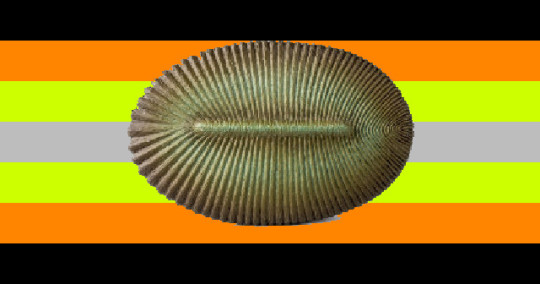
Dickinsonia from the Ediacaran Period is Forklift Certified!
142 notes
·
View notes
Text

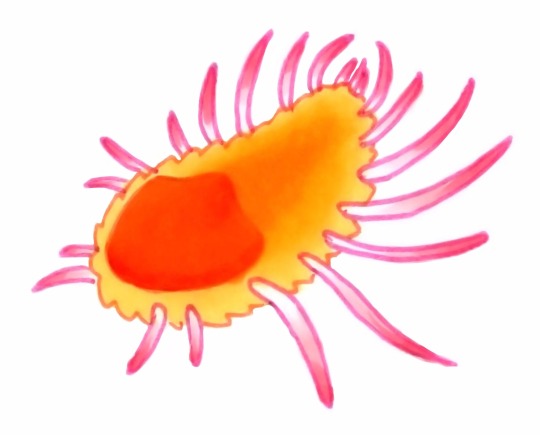

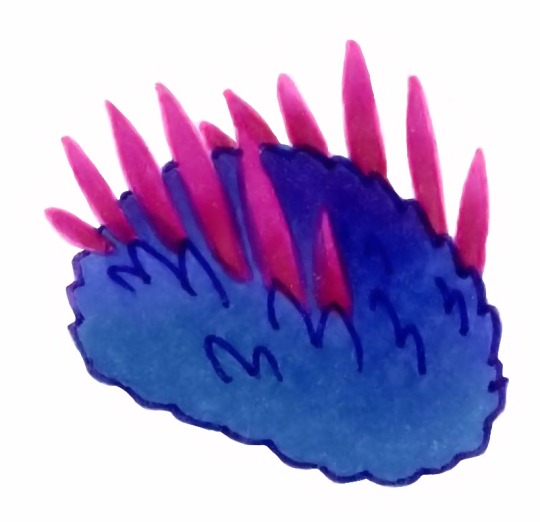

Very old critters in new colours
Dickinsonia | Orthrozanclus
Burgessia
Wiwaxia | generic Trilobite
#lgbt#traditional art#copicmarkers#pride#cambrian#ediacaran#gay#queer#translobite hehehe#would have gone for a specific trilobite but couldn't come up with a pun so :/#(yes they're all puns thanks for noticing <3)#palaeo#(gay lesbian mlm bi trans)
2K notes
·
View notes
Text
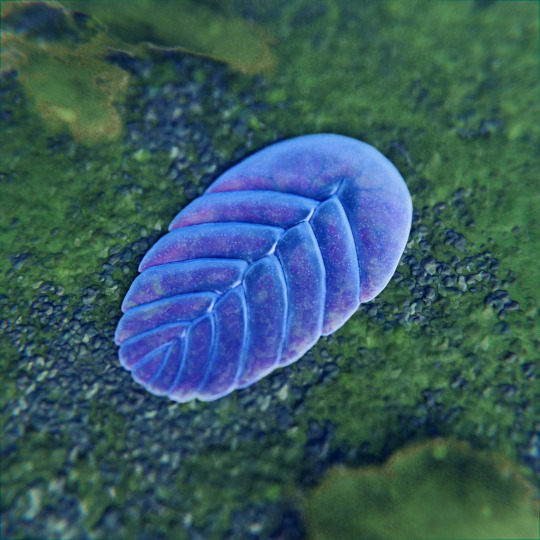
Vendia sokolovi, a 1 cm-long enigmatic* organism from the upper Ediacaran of Russia (displaying the 'glide symmetry' characteristic of many Ediacaran forms), feeding (?) on the bacterial mats that used to be widespread before the Cambrian explosion.
*as Ediacaran organisms tend to be, alas
Some art I made a long time ago but still find kind of neat.
References:
Ivantsov, A. (2001). Vendia and Other Precambrian 'Arthropods'. Paleontological Journal, 35(4), 335-343. https://www.academia.edu/2605872/Vendia_and_Other_Precambrian_Arthropods_
Ivantsov, A. (2004). New Proarticulata from the Vendian of the Arkhangel’sk Region. Paleontological Journal, 38(3), 247–253.
#vendia#proarticulata#ediacaran biota#whatever they are#ediacaran#proterozoic#precambrian#paleontology#palaeoblr#paleoart#my art
405 notes
·
View notes
Text
@a-dinosaur-a-day's scuba certification didn't allow you to go past the Ediacaran, but now you can! With the new formula focusing on Earth's earlier times, when will you go?
152 notes
·
View notes
Text


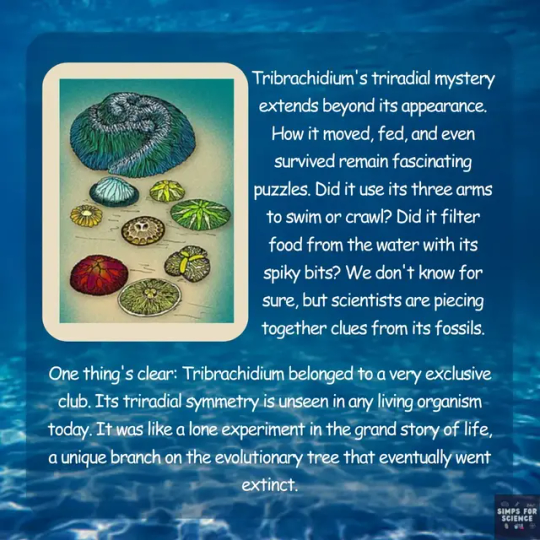

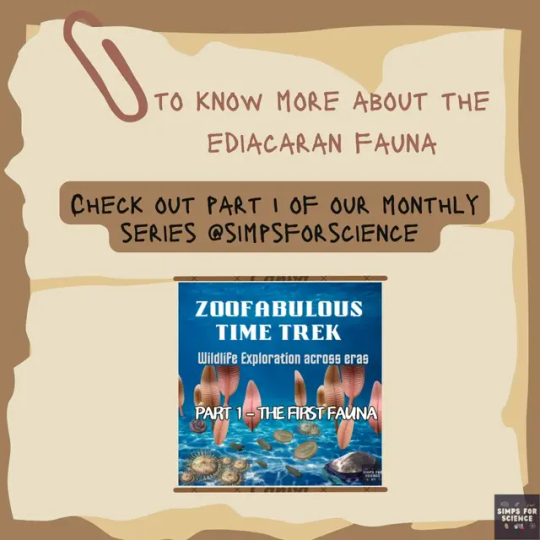
The strokes from Evolution's paintbrush🖌️ created a kaleidoscope of animal body symmetries. 🎨 Triradial symmetry is the rarest and most intriguing of them all !😃 Swipe➡️ to dive deeper🤿 into this rarest marvel of the animal world.To know more about the ancient animals, follow our monthly 🗓️series - Zoofabulous Time Trek!
📸Image credits:
1. Apokryltaros, Wikimedia commons
2. Aleksey Nagovitsyn, Wikimedia commons
3. Ghedoghedo, Wikimedia commons
4. Nobu Tamura, Wikimedia commons
#education#science#science facts#study blog#research scientist#discover#scicomm#zoology#earth#animals#symmetry#fauna#wildlife#precambrian#ediacaran#explore#evolution#paleontology#archaeology#fossils#biology#ancient animals#nature#charles darwin#geology
56 notes
·
View notes
Text

Charnwood Forest
Leicestershire, England, circa 560 million years ago. A fossil found here in 1956 by a local, Tina Negus, turned out to be the first solid evidence that complex lifeforms existed before the Cambrian Period. Subsequent discoveries hint that the site was a deep-water environment hosting a myriad of organisms.
174 notes
·
View notes
Text

i made a meme
#mine#spriggina#ediacaran#australian prehistory#paleoblr#paleo meme#paleontology#precambrian#cambrian#image
105 notes
·
View notes
Text
Screw returning to monkey. Return to dickinsonia.
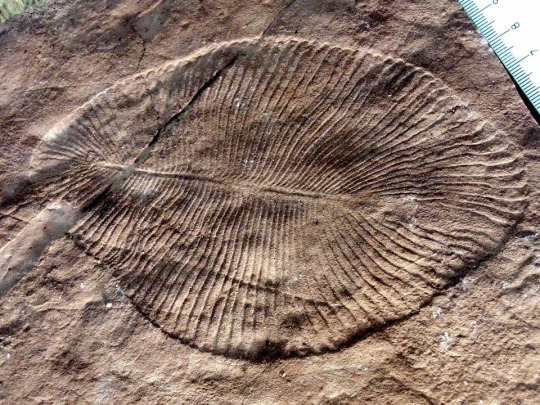
Moisturized. In her lane. Barely comprehensible.
#disclaimer i know we're not descended from these guys lmao#ediacaran#ediacaran biota#dickinsonia#precambrian#prehistory#paleontology#geology
123 notes
·
View notes
Text

Charnia
In the distant past of our planet, deep beneath the waves of the ocean, a strange creature has made a living in the pitch black of the deep sea.
Harvesting the energy of a hydrothermal vent, a colony of Charnia glows ghostly in the floodlight of the submarine. What exactly are they? Animal, plant, something entirely different? Finally, this question will be answered…
#art#mine#digital#paleoart#ediacaran#charnia#deep sea#ocean#hydrothermal vents#black smoker#barren#empty#thalassophobia
30 notes
·
View notes
Text
Strange Symmetries #01
Most animals are bilaterally symmetric, having body plans with mirrored left and right sides – which also allows them to have a defined head end, rear end, top side, and underside.
It's not entirely clear what evolutionary advantage this type of symmetry gave to the first bilaterians, which would have been been small "simple" worm-like animals living sometime during the Ediacaran Period between 600 and 560 million years ago. The current generally accepted explanation is that it probably allowed for better active locomotion – clustering sense organs at the head end and directing body movement more efficiently towards food sources and away from threats.
However, this sort of symmetry is never completely perfect. Internal structures like organs are often arranged nonsymmetrically, and the realities of genetics, physical development, and environmental influences always result in external small deviations.

Zebra From The Back by Lynn Greyling | CC0 Public Domain
…But not every bilaterian has stayed roughly symmetrical.
Over the last half-billion years or so some bilaterians have abandoned their roughly-mirror-image body plans in favor of something distinctly wonkier. Asymmetry has evolved multiple times in various different lineages, and so every weekday this month we'll be looking at some examples.
And we might as well start way back near the beginning:
———
Strange Symmetries #01: Almost Bilateral
Living in the Ediacaran between about 567 and 550 million years ago, the proarticulatans were flattened rounded organisms with two rows of soft "quilted" rib-like segments (known as isomers) and sometimes a larger fused "head" section at the front. The left and right isomers weren't perfectly mirrored, instead being offset from each other in a glide reflection pattern – but the presence of a clear central body axis suggests these animals may have had some sort of relation to the earliest bilaterians, possibly even being a very early stem group that was experimenting with a not-quite-totally-bilateral body plan.

Discovered in what is now northwest Russia, and dating to around 555 million years ago, Vendia sokolovi was a small proarticulatan measuring about 1.1cm long (0.4"). It had a rather small number of isomers compared to some of its relatives, only 7 per side, and seems to have had a simple digestive tract that branched into each isomer.
(The superficial resemblance to trilobites was coincidental – while we might not be entirely sure what these things were, we do at least know they weren't closely related to early arthropods.)
Very little overall is known about these animals' lifestyles. Trace fossils suggest they were able to move around, feeding on microbial mats on the seafloor, and they may also have been able to firmly stick themselves onto the spots they were currently grazing.
———
NixIllustration.com | Tumblr | Twitter | Patreon
#science illustration#strange symmetries#paleontology#paleoart#palaeoblr#vendia#proarticulata#ediacaran#bilateria#maybe#art#asymmetry#glide reflection
253 notes
·
View notes
Text
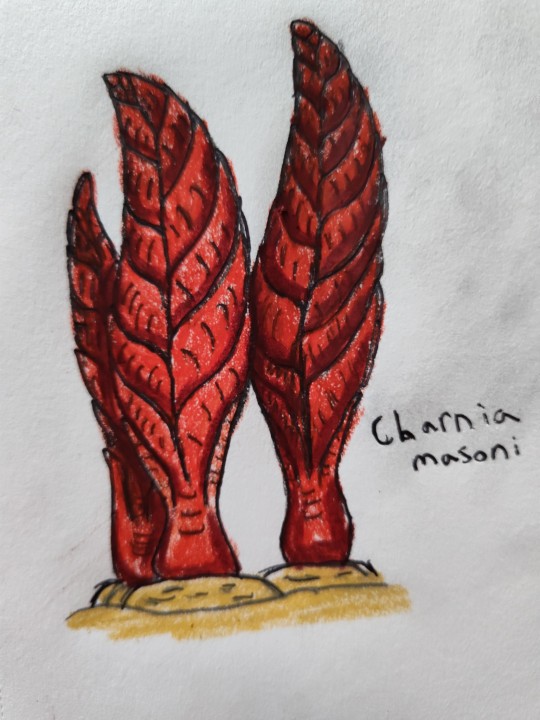
In 1957, schoolboy Roger Mason and his friends were rock climbing in Charnwood Forest in central England where they stumbled across a strange leaf-like pattern embedded in the rocks. The unusual fossil was brought to the attention of local geologist Trevor Ford, who published the discovery in the Journal of the Yorkshire Geological Society. This fossil is particularly fascinating as the rock layers in the area are known to be Precambrian in age. A time previously thought to be prior to the appearance of complex life.
Charnia (named after the Charnwood Forest in which it was discovered) was an unusual frond-like lifeform from the late Ediacaran period, 570-550 Mya. It had segmented leaf-like ridges branching out from the center asymmetrically, indicating it likely evolved before bilateral symmetry, a feature present in nearly every living thing today. Specimens have been found ranging anywhere from 1cm to 66cm in length. It lived on the sea floor feeding on nutrients in the water, and despite its plant-like appearance, the nature of the fossil beds it was discovered in indicates it lived too deep to effectively photosynthesize like plants do. Instead, our current understanding of the lifeform places it as an early member of the animal kingdom.
Charnia is a significant discovery as it is the first Precambrian fossil to be identified as such, completely changing our understanding of how life came to be. So little is currently known about Ediacaran biota that we don't know how or even if these creatures are related to life today.
#charnia#paleoart#paleontology#evolution#ediacaran#precambrian#animal art#animals#animal#fossils#fossil
9 notes
·
View notes
Text
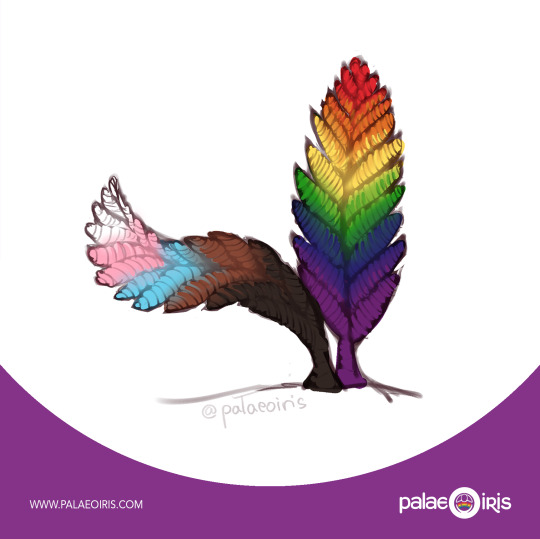
Progress Pride Flag + Charnia sketch
#charnia#ediacaran#ediacaranfauna#agender#agenderpride#nature#queer#stem#prideinSTEM#queerinstem#sciart#scienceart#scienceillustration#queerinscience#LGBTinSTEM#queerowned#lgbtqcommunity#LGBTowned#lgbtqiaowned#LGBTbusiness#LGBTQIAbusiness#queerbusiness#queerillustration#palaeoart#paleoart#STEMPride#paleofauna#paleoreconstruction#queerscience
7 notes
·
View notes
Text
Ediacaran Glasses Chain

I made a new glasses chain themed around the Ediacaran period.
I made the Ediacaran frond cameos by gluing pebbles and leaf-shaped beads to blank pendant trays and painting the background with nail polish.
I made the jellyfish by threading strings of teensy tiny purple beads onto the edges of some bead caps.
The faux pearls might seem out of place, but there was at least one species in the Ediacaran that is thought to be an early ancestor of mollusks if not a mollusk itself, and all modern mollusks technically can create pearls, even if it's uncommon.
https://en.m.wikipedia.org/wiki/Temnoxa_molluscula Here is the Ediacaran "mollusk" I referred to earlier.
38 notes
·
View notes
Photo

Some drawings I did in photoshop of Trilobozoa because I wanna get a tattoo of them. I think it’d be neat if I got glow-in-the-dark ink for the light parts. Definitely not enough art out there of these beauties.
#trilobozoa#paleontology#precambrian#ediacaran#tribrachidium#anfesta#rugoconites#extinct species#paleoart#ocean creatures
36 notes
·
View notes